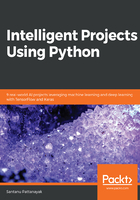
What this book covers
Chapter 1, Foundations of Artificial Intelligence Based Systems, covers the basics of how to build smart artificial systems using machine learning, deep learning, and reinforcement learning. We will be discussing various artificial neural networks, including CNNs for image processing purposes and RNNs for natural language processing purposes.
Chapter 2, Transfer Learning, covers how to use transfer learning to detect diabetic retinopathy conditions in the human eye, and to determine the retinopathy's severity. We will explore CNNs and learn how to train a model with CNN that is capable of detecting diabetic retinopathy in fundus images of the human eye.
Chapter 3, Neural Machine Translation, covers the basics of recurrent neural network (RNN) architectures. We will also learn about three different machine translation systems: rule-based machine translation, statistical machine translation, and neural machine translation.
Chapter 4, Style Transfer in Fashion Industry using GANs, explains how to create a smart AI model to generate shoes with a similar style to a given handbag and vice versa. We will be using the Vanilla GAN to implement the project using customized versions of the GAN, such as a DiscoGAN and a CycleGAN.
Chapter 5, Video Captioning Application, discusses the role of CNNs and LSTMs in video captioning and explains how to build a video captioning system leveraging the sequence to sequence—video to text architecture.
Chapter 6, The Intelligent Recommender System, discusses recommender systems, which are information filtering systems that deal with the problem of digital data overload to pull out items or information according. We will be using latent factorization for collaborative filtering and use a restricted Boltzmann machine to build recommendation systems.
Chapter 7, Mobile App for Movie Review Sentiment Analysis, explains how machine learning as a service is used to benefit mobile apps. We will be creating an Android mobile app using TensorFlow that will take reviews of movies as input and provide a rating based on sentiment analysis.
Chapter 8, Conversational AI Chatbots for Customer Service, explains how chatbots have evolved during and looks at the benefits of having conversational chatbots. We will also be looking into how to create chatbots and what LSTM sequence-to-sequence models are. We will also be building a sequence-to-sequence model for a Twitter support chatbot.
Chapter 9, Autonomous Self-Driving Car Through Reinforcement Learning, explains reinforcement learning and Q-learning. We will also be crating a self-driving car using deep learning and reinforcement learning.
Chapter 10, CAPTCHA from a Deep-Learning Perspective, we discusses what CAPTCHAs are and why they are needed. We will also be creating a model to break CAPTCHAs using deep learning and then how to generate them using adversarial learning.